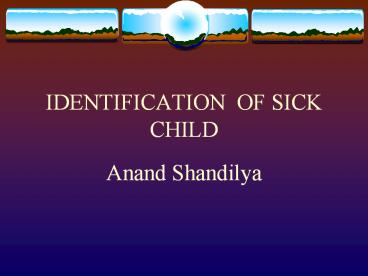IDENTIFICATION OF SICK CHILD - PowerPoint PPT Presentation
Title:
IDENTIFICATION OF SICK CHILD
Description:
IDENTIFICATION OF SICK CHILD Anand Shandilya SICK CHILD or CRITICALLY ILL CHILD Is a child who is in a clinical state which may result in respiratory or cardiac ... – PowerPoint PPT presentation
Number of Views:551
Avg rating:3.0/5.0
Title: IDENTIFICATION OF SICK CHILD
1
IDENTIFICATION OF SICK CHILD
- Anand Shandilya
2
SICK CHILD or CRITICALLY ILL CHILD
- Is a child who is in a clinical state which may
result in respiratory or cardiac arrest or severe
neurological complication , if not recognized
treated promptly.
3
- It is important to identify a child with
physiological derangement in its early stages
when signs are subtle. - GOLDEN HOUR concept applies to all children with
illness presenting as EMERGENCY
4
- Early recognition of a critically ill child
requires a systematic rapid clinical
assessment with background knowledge of age
appropriate physical signs developmental level. - The process of examining a child is known as
RAPID CARDIOPULMONARY ASSESSMENT. - 30 secs with practice.
5
Selected conditions require a rapid
cardiopulmonary assessment
- RR gt60
- HR gt180 or lt80(under 5yrs)
- gt160 or lt60(over 5yrs)
- Respiratory distress-increased work of breathing
(retractions,nasal flaring,grunting). - Trauma ,Burns totaling gt10 of surface area .
- Cyanosis
6
- Failure to recognize parents
- Diminished level of consciousness unusal
irritability, or lethargy. - Seizures
- Fever with petechiae
7
Simple quick way of assessment
- Appearance of child
- Airway
- Breathing
- Circulatory status
8
APPEARANCE OF CHILD
- Basically denotes NEUROLOGICAL STATUS.
- It is determined by the o2 blood supply to the
brain which is dependent on cardiopulmonary
status and structural integrity of the brain.
9
- 1 ALERTNESS Changes in level of conscious can
also be rapidly assessed by - A wake
- Responsive to V oice
- Responsive to P ain
- U nresponsive
10
- Distractibility or consolability by parent.
- Eye contact with parent or physician normally at
2mon .failure to do this is an EARY OMINOUS SIGN
of cortical hypoperfusion brain dysfunction. - SPEECH /CRYnormal/moaning/high pitched.
- MOTOR ACTIVITY normal movements of
limb,trunk,neck
11
- COLOR of SKIN pink,pale/cyanosed/mottled/ashen
grey. - SEIZURE activity
- POSTURING
- MUSCLE TONE-limp child bad sign.
- Pupil size
12
AIRWAY
- Whether it is open clear or maintainable with
adjuncts like airways suction ,positioning or
unmaintainable without intubation.
13
BREATHING
- RESPIRATORY RATE
- Tachypnoea is an early sign of resp distress.
- Tachypnoea with out IWB shock,heart disease
acidosis. - Slow/irregular RR in a acutely ill child is
OMINOUS. - WORK OF BREATHING
- AIR ENTRY.
14
CIRCULATORY STATUS
- HEART RATETachycardia
- Bradycardia in a
critically ill child OMINOUS. - PULSESCentral/Peripheral
- present/absent
- volume
- pulse pressure
- Loss of central pulse is a premorbid sign is to
be treated as cardiac arrest.
15
- SKIN PERFUSIONTemperature
- color
- CFT
16
- ORGAN PERFUSIONBrain perfusion
- Renal
perfusion - BLOOD PRESSURE
17
- PULSE OXIMETRYo2 saturation assessment is an
important adjunct to identify oxygenation state
in acutely ill child.
18
THANK YOU

